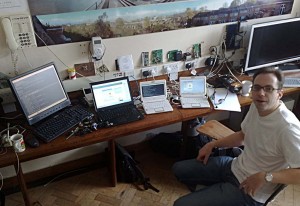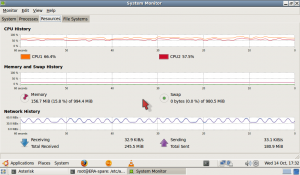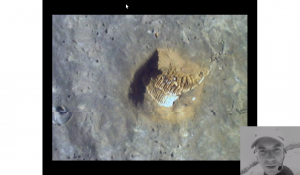 Following the release of the new 9.10 ‘Karmic Koala’ version of Ubuntu, we installed it on one of the Asus 901s, trying out a new configuration of all ext4 disk partitions and no swap partition. Discovering that the ‘Netbook Remix’ (UNR) release of the operating system now could only use the mobile phone look-alike interface and had the Desktop-Switcher package removed, we followed forum advice and tried the full Ubuntu 9.10 release instead. Having disabled the ‘wobbly windows’ graphics enhancements in Gnome, Ubuntu 9.10 was no trouble on the Asus 901 – all the devices worked from the start, dialogue and menu boxes fitted in the available screen area by default. One of the main reasons for trying Ubuntu 9.10 was to experiment with an early desire of ERA to use the bluetooth audio headsets commonly available for mobile phones instead of wired mic-and-headphones devices. With our Ubuntu 9.04 UNR installations we couldn’t get this to work, despite spending a frustrating day or two in early July with the latest software then available. At that time, improved bluetooth interaction with beta Pulseaudio releases and experimental device control with Blueman were not integrated into Ubuntu releases, but promised to make bluetooth audio as simple under Ubuntu as it is on a mobile phone.
Following the release of the new 9.10 ‘Karmic Koala’ version of Ubuntu, we installed it on one of the Asus 901s, trying out a new configuration of all ext4 disk partitions and no swap partition. Discovering that the ‘Netbook Remix’ (UNR) release of the operating system now could only use the mobile phone look-alike interface and had the Desktop-Switcher package removed, we followed forum advice and tried the full Ubuntu 9.10 release instead. Having disabled the ‘wobbly windows’ graphics enhancements in Gnome, Ubuntu 9.10 was no trouble on the Asus 901 – all the devices worked from the start, dialogue and menu boxes fitted in the available screen area by default. One of the main reasons for trying Ubuntu 9.10 was to experiment with an early desire of ERA to use the bluetooth audio headsets commonly available for mobile phones instead of wired mic-and-headphones devices. With our Ubuntu 9.04 UNR installations we couldn’t get this to work, despite spending a frustrating day or two in early July with the latest software then available. At that time, improved bluetooth interaction with beta Pulseaudio releases and experimental device control with Blueman were not integrated into Ubuntu releases, but promised to make bluetooth audio as simple under Ubuntu as it is on a mobile phone.
Tag Archives: VoWLAN audio
Trunking calls between Asterisk servers with IAX2.
At the end of last week we managed to create an IAX to IAX trunk between 2 asterisk servers on the local wired LAN. IAX trunking is a way to connect multiple Asterisk servers and allow clients of different servers to place calls to each other. Continue reading
MeetMe testing
Last Wednesday we did some testing of our Asterisk MeetMe setup, at dekspc medialab in London. Setting up the Asterisk server on the local wired LAN and assembling an assortment of 6 SIP clients, using Ekiga on both Windows and Linux platforms, and a Mac running the SIP client Telephone. Each client registered with Asterisk as users era1 -> era9 and dialled ‘1234’ for the MeetMe conference room. Continue reading
Set up Asterisk conference calling with MeetMe.
I made my first (2-way) conference call on Asterisk/Meetme just now. To enable MeetMe with Asterisk, you first need to edit your meetme.conf in /etc/asterisk/ , mine looks like this:
Using smartphones as …phones.
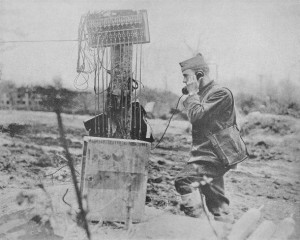
An early outdoor phone exchange
Could it be that the way to make a telephone call on a geology site would be to use a telephone? Now we seem to have some fairly stable WiFi networking hardware, and are considering that we might ditch the awkward netbooks for our ‘Sherpas’ in the field, perhaps we could use WiFi equipped smartphones for some of our outdoor networking needs?
Since we’re using SIP, we’ll need SIP software for any mobile phones we use, and there are obvious commercial reasons why most mobile service providers aren’t keen on this, but on the up side, bluetooth headsets are designed to be used with mobile phones so this could add another useful feature to the ERA toolkit.
Testing voice and video at the edge
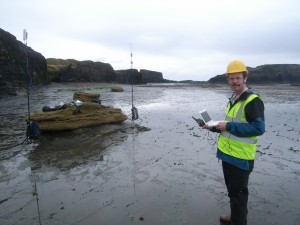
Chris on Whitby foreshore testing voice and video, with field antennae in the background
Today we went to Whitby to explore the field localities on the beach there, and also to see how far we could connect using just a single node.
In the morning we set up the base station in the car at the top of the cliffs, with a single Nanostation 2 access point, and Chris and Trevor headed off down onto the shore to explore the site. Quite a walk across the rocks and onto some interesting geology below the tide line, and with a turning tide Mark was posted not only to watch their progress but also keep an eye on the North Sea!
We made a really solid connection with two Nanostations connecting to each other and streaming voice and video smoothly between the two Asus Eee PC laptops that were connected by wire to these access points. A good few hundred metres distance covered, data to be analysed. Testing had to be cut short though as the incoming tide threatened to cut off the shore team and so it was off for the fabled fish and chips of the town for lunch.
The afternoon saw us back in the same location, but exploring how far we could push a signal from just a single Nanostation access point to a laptop on the beach over a couple of hundred metres. We ran iperf ans iwscan tests to check bandwidth and jitter rates and then tried setting up video calls. Suprisingly good connectivity was made, despite the distance. Clearly though we’re pushing the edge of what the kit can do and we found that by locking the video back to 2.048Mb/s from 3.096Mb/s give the audio a greater slice of the bandwidth and really improves its quality. Good quality audio really feels the key to giving the sense of an assured, seamless connection. We had a couple of crashes with the Ekiga video software at the edge of its range but generally this seems to be working really well on the Asus 901 PCs. We’re using walkie talkies as a backup channel as we know we’re pushing the equipment to its limit and will lose signal sometime; with line of sight we’re assured we can chat to each other, which is more than we can assume with mobile phones here!
We gathered the GPS readings from all the locations and we’ll put up the details shortly.
Clifftop multi-hop: Scremerston
Today’s visit brought us to the dramatic coastal features of Scremerston, just south of Berwick-upon-Tweed. This is a tough location for Assisted Requirements students as the high, steep cliff face can be quite challenging to negotiate for anyone. The closest practical access is down a gravelled lane (which could be driven up at a push), stopping before the gate to a muddy field full of cows. From there, the beach site (which should be visited on a falling tide) is accessed down a grassy cliff face 300m or so from the gate. From the beach access, the geological study site is quite stretched out along the sea front, with features jutting out from the cliff base into the sea.
Second field tests at Old Wolverton
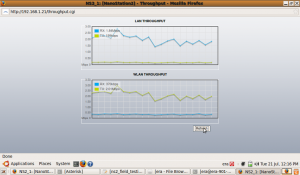
Screenshot of Nanostation 2 bandwidth testing at Old Wolverton, displayed on Asus Eee PC running Ubuntu
Today we carried out our second set of field tests. This time using our new Ubiquity Nanostation2 wifi routers. In the morning Chris, Mark and John started with a radio site survey, then did a single wifi link of about 460 meters, and had a quick check of the video streaming software (mjpgstreamer) in one direction and a two-way voip call.
First VoWLAN field tests
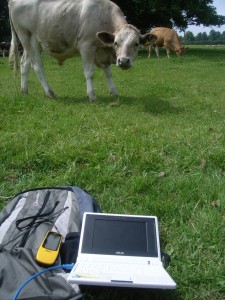
Curious cows. A hazard that distinguishes our field testing from our lab based testing.
Today we did our first set of antenna tests as part of the JISC funded Portable VoWLAN project. We went out into the wilds of Old Wolverton and set up a pair of Linksys WRT 54GL routers at a distance of 100 meters in the morning and then a distance of 1.3 kilometers in the afternoon, to compare the performance of a range of antenna.
We used the iperf program to identify the (tcp) bandwidth and (udp) jitter values from a 60 second test. Here’s a quick summary of the findings…
